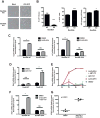Apoptotic caspases prevent the induction of type I interferons by mitochondrial DNA
- PMID: 25525875
- PMCID: PMC4272443
- DOI: 10.1016/j.cell.2014.11.037
Apoptotic caspases prevent the induction of type I interferons by mitochondrial DNA
Abstract
The mechanism by which cells undergo death determines whether dying cells trigger inflammatory responses or remain immunologically silent. Mitochondria play a central role in the induction of cell death, as well as in immune signaling pathways. Here, we identify a mechanism by which mitochondria and downstream proapoptotic caspases regulate the activation of antiviral immunity. In the absence of active caspases, mitochondrial outer membrane permeabilization by Bax and Bak results in the expression of type I interferons (IFNs). This induction is mediated by mitochondrial DNA-dependent activation of the cGAS/STING pathway and results in the establishment of a potent state of viral resistance. Our results show that mitochondria have the capacity to simultaneously expose a cell-intrinsic inducer of the IFN response and to inactivate this response in a caspase-dependent manner. This mechanism provides a dual control, which determines whether mitochondria initiate an immunologically silent or a proinflammatory type of cell death.
Copyright © 2014 Elsevier Inc. All rights reserved.
Figures







Comment in
-
Cell death. Silencing the immune response of apoptotic cells.Nat Rev Immunol. 2015 Feb;15(2):68-9. doi: 10.1038/nri3808. Epub 2015 Jan 19. Nat Rev Immunol. 2015. PMID: 25598532
References
-
- Cai X, Chiu YH, Chen ZJ. The cGAS-cGAMP-STING Pathway of Cytosolic DNA Sensing and Signaling. Molecular cell. 2014;54:289–296. - PubMed
-
- Callus BA, Vaux DL. Caspase inhibitors: viral, cellular and chemical. Cell death and differentiation. 2007;14:73–78. - PubMed
-
- Chipuk JE, Green DR. Do inducers of apoptosis trigger caspase-independent cell death? Nature reviews Molecular cell biology. 2005;6:268–275. - PubMed
Publication types
MeSH terms
Substances
Associated data
- Actions
Grants and funding
LinkOut - more resources
Full Text Sources
Other Literature Sources
Molecular Biology Databases
Research Materials

